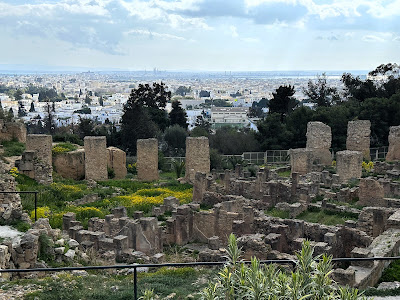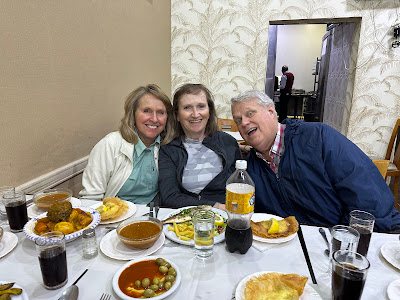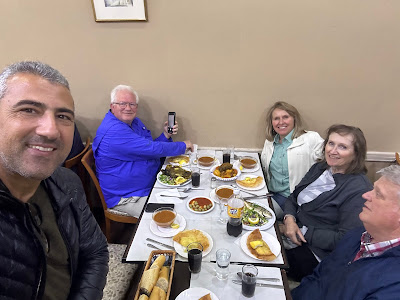March 22, 2024
We had two more destinations on our last day in Tunisia, three if you count dinner. The first was the North Africa American Cemetery, 27 acres dedicated in 1960 to hold 2,841 of our troops killed in the North Africa campaigns of World War II.
There are 26 American military cemeteries outside of the US, and this is the only one on the African continent.
I was intrigued by the trimming of these trees, and that's a lot of manicured green lawn, don't you think?
They had a Purple Heart on display and a document signed by Lyndon Johnson. On the page on the right, a passage reads: "The Purple Heart has been conferred individually upon those buried or commemorated here who gave their lives in action."
The crosses set in strait rows remind me both of soldiers standing at attention and of an orchard of fruit trees, two conflicting images.
This was not a destination we had talked to our guide Feker about. We had never heard of it! He brought us here because he knew we would like it. The American Cemetery at Normandy is much, much larger than this one, and it has over three times the number of soldiers interred, but there was something about this beautifully maintained and very quiet spot that really touched me. It is a testament that no soldier is forgotten, that each life given in service to one's country is valued.
As in most, if not all, military cemeteries, there was a Tomb of the Unknown Soldier, but this one is positioned on a beautiful mosaic that reads: "Some there be which have no sepulchre. Their name liveth for evermore."
In case visitors don't know much about the conflict in North Africa (and most of us don't), there is some educational material on a covered walkway that is as beautiful to look at as it is informative. These three maps that show the movement of troops in 1942-1943 are made of tiles:
More memorials to the US forces are inscribed on the walls in English, Arabic, and French:
Finally, a small Christian chapel is provided for prayers and meditation.
If you want to learn more about the North Africa American Cemetery or the North Africa Campaign of World War II, this great video is a good place to start:
Moving on!
One of the reasons Bob was excited about going to Tunisia was to see Carthage, which for a long time was the largest and wealthiest city in North Africa, and perhaps in the entire Mediterranean region. However, it is most remembered for its bitter war with its rival power, Rome. Built on a peninsula on Tunisia's Mediterranean coast, Carthage controlled the ships passing between Sicily and North Africa, making it a thriving trading center and major power that threatened Rome's existence.
The wars between Rome and Carthage are known as the Punic Wars, which lasted from 264 to 146 BC. The Second Punic War includes Hannibal's ride over the Alps on elephants. At the end of the Third Punic War, Rome completely destroyed Carthage and established itself as the ruler of all of the Carthaginian lands and peoples.
Carthage has a beautiful view of the Mediterranean.
It is a relatively silent, wind-swept hill of rocky monuments reminiscent of a graveyard.
Wildflowers fill in the gaps between stones and walls.
The sweet scent of orange blossoms seems almost out of place, but it's here, nevertheless.
Without the heavy ornamentation that often comes with a cathedral, it is open and airy inside.
There are stained glass windows, but they are not religious in theme.
I'm always looking at ceilings. There were some interesting ones in the Acropolium.
My favorite part of the interior, however, was these Arab-style keystone arches. I would assume they were part of the original cathedral structure, but maybe they were added in a remodel after this became a community center.
After Carthage fell, the Romans moved in and Julius Caesar built a new city on top of the old one between 49-44 BC, and by the first century, it was the second-largest city in the western Roman Empire. However, with a population of 500,000, it was nowhere near the size of the original city, which had 4 million people.
The hollow torso of a statue is perched on one of the rocks.
Wildflowers fill in the gaps between stones and walls.
The sweet scent of orange blossoms seems almost out of place, but it's here, nevertheless.
The sense of ennui even reached to the dogs wandering through.
In 1994, archaeologists discovered what they have named the "Sepulchre of the Young Man of Byrsa," a Punic tomb with an 4 meter long access shaft and an underground burial chamber. It dates to the second half of the 6th century BC.
I don't remember if this statue was in the tomb or somewhere else, but I got a kick out of his carefully placed green leaf.
What looked to us like a Catholic church sits on a hill overlooking this section of Carthage. It turns out that it was once St. Louis Cathedral, a Roman Catholic church built between 1884 and 1890 and dedicated to St. Louis, who allegedly died on this spot during the Eighth Crusade in 1270. However, the Catholic church ceded almost all of its real estate to the Tunisian sate, including this building in 1964. Since 1992 it has been used as a cultural center known as the "Acropolium."
Souvenir vendors in the parking lot of the church/community center, and Bob bought an olive tree mosaic for 120 dinar (about $40) that looks very nice on our bookshelf.
During the Roman rule between 157 and 162 AD, the most famous and largest thermal baths in Africa were built, the Antonin (aka Antoninius) Baths, named for the Roman emperor Antonius the Pious. The baths were originally mixed gender, but Hadrian separated genders and dedicated the baths to women in the morning and men in the afternoon. The baths operated until the end of the 4th century, when some of the vaults collapsed. Later, columns were pilfered from the site to be used in the mosques of Kairouan and Tunis, or exported to Turkey or Italy. According to information at the site, the cathedral of Pisa is said to have been partially built with Carthaginian materials.
Most of the ruins of the baths are what was underground--the passageways, holding tanks, "machine rooms," etc. The fancy above-ground structures are few, which is evident in the video and panaromic photo below. Note how flat the tops of the structures are.
What makes it even more difficult for archaeologists is that other structures, including burial grounds were built on or in the baths after their demise. It wasn't always obvious what we were looking at. They could use more signage.
Like the Carthage ruins we had visited earlier, the view is spectacular.
The plan of the first floor shows two sides that mirror each other and there is a "frigidarium" and "caldarium" between them--cold and hot water places.
Plenty of intriguing doorways leading to mysterious places.
Truncated columns lay scattered about like orphaned wheat stalks in a poorly done harvest.
This singularly tall column can be easily picked out in the panorama shot above. It is enormous and gives a good idea of what the above-ground structures may have looked like.
Feker the Photographer at work again.
A bunch of antiquities gathered together in one photo.
It's time for dinner! Off we go.
Once seated in the restaurant, we marveled yet againat the ease with which the patrons put off eating and drinking until a signal (which we never seemed to catch) was given. At that point what most of them did was take a few long gulps of water before beginning to eat.
Each of us ordered brik, the egg-filled savory pastry that was consistently good, and a bowl of lentil soup that was not so spicy and the best we had in Tunisia.
It was our last night in Tunisia, so why not be adventurous? I ordered cow's stomach stuffed with beef and veggies. I had seen the paper-thin sheets of cow stomach hanging up in the meat market. Knowing the stomach part would be thin made it seem more palatable somehow. It turned out to be quite good, although at one point I got a larger piece of the stomach and the texture over-powered me. I had to discretely spit it out into my napkin. The meat came on top of what looked like a gallon of couscous and a large amount of roasted vegetables, all good but way too much quantity for me.
Chris had fried fish that looked good and NO couscous (lucky her). I didn't record what Stan had.
And Bob finally got his longed for roasted sheep's head--or actually half a sheep's head, cleaved down the center from crown to chin. His serving included half the brain, half the tongue, and one eye, each of which he joyfully consumed. (That's the eye in the photo below right.)
We walked back to our hotel for an early night and to prepare for our flight to Rome in the morning.
MOVIE
As I was looking at my photos of the maps at the American Cemetery, it came to me that the 1970 movie Patton would be a fitting follow-up movie to this post. Patton led the US forces in North Africa and Sicily, and we should now have a totally different feel for both places.
The movie was excellent. After all, it won seven academy awards, including Best Picture, Best Actor (George C. Scott), Best Director, Best Original Screenplay (Francis Ford Coppola), and more. I learned a lot about the North African Allied Campaign, as well as the defeat of the Germans on Sicily. And that Patton--what a guy. While he seemed to be a narcissist, he did achieve a lot, but at the expense of many American lives.


















































































The American Cemetery was a nice visit. In Patton, his visit to the ruins of Carthage was well inland and I assume was a substitute Carthage unless there are additional ruins inland. Curious, I just looked it up and the scene in the film was from Volubilis in Morocco, which we visited a number of years ago. Patton also visited Malta, and of course, Sicily, so it really was a good movie for a trip follow-up.
ReplyDelete